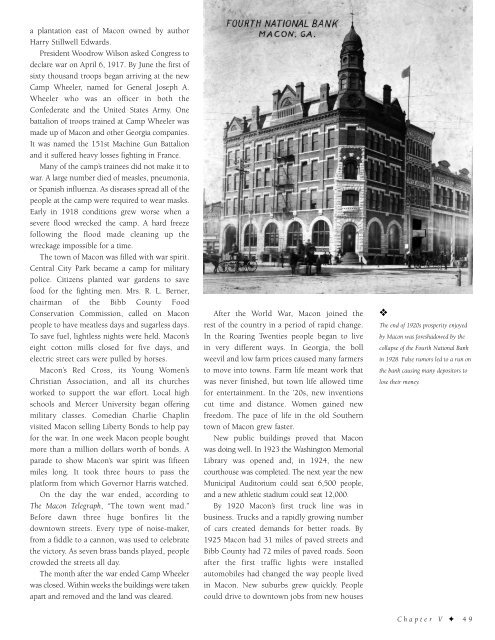Historic Macon
An illustrated history of the city of Macon, paired with the histories of companies, families and organizations that make the region great.
An illustrated history of the city of Macon, paired with the histories of companies, families and organizations that make the region great.
You also want an ePaper? Increase the reach of your titles
YUMPU automatically turns print PDFs into web optimized ePapers that Google loves.
a plantation east of <strong>Macon</strong> owned by author<br />
Harry Stillwell Edwards.<br />
President Woodrow Wilson asked Congress to<br />
declare war on April 6, 1917. By June the first of<br />
sixty thousand troops began arriving at the new<br />
Camp Wheeler, named for General Joseph A.<br />
Wheeler who was an officer in both the<br />
Confederate and the United States Army. One<br />
battalion of troops trained at Camp Wheeler was<br />
made up of <strong>Macon</strong> and other Georgia companies.<br />
It was named the 151st Machine Gun Battalion<br />
and it suffered heavy losses fighting in France.<br />
Many of the camp’s trainees did not make it to<br />
war. A large number died of measles, pneumonia,<br />
or Spanish influenza. As diseases spread all of the<br />
people at the camp were required to wear masks.<br />
Early in 1918 conditions grew worse when a<br />
severe flood wrecked the camp. A hard freeze<br />
following the flood made cleaning up the<br />
wreckage impossible for a time.<br />
The town of <strong>Macon</strong> was filled with war spirit.<br />
Central City Park became a camp for military<br />
police. Citizens planted war gardens to save<br />
food for the fighting men. Mrs. R. L. Berner,<br />
chairman of the Bibb County Food<br />
Conservation Commission, called on <strong>Macon</strong><br />
people to have meatless days and sugarless days.<br />
To save fuel, lightless nights were held. <strong>Macon</strong>’s<br />
eight cotton mills closed for five days, and<br />
electric street cars were pulled by horses.<br />
<strong>Macon</strong>’s Red Cross, its Young Women’s<br />
Christian Association, and all its churches<br />
worked to support the war effort. Local high<br />
schools and Mercer University began offering<br />
military classes. Comedian Charlie Chaplin<br />
visited <strong>Macon</strong> selling Liberty Bonds to help pay<br />
for the war. In one week <strong>Macon</strong> people bought<br />
more than a million dollars worth of bonds. A<br />
parade to show <strong>Macon</strong>’s war spirit was fifteen<br />
miles long. It took three hours to pass the<br />
platform from which Governor Harris watched.<br />
On the day the war ended, according to<br />
The <strong>Macon</strong> Telegraph, “The town went mad.”<br />
Before dawn three huge bonfires lit the<br />
downtown streets. Every type of noise-maker,<br />
from a fiddle to a cannon, was used to celebrate<br />
the victory. As seven brass bands played, people<br />
crowded the streets all day.<br />
The month after the war ended Camp Wheeler<br />
was closed. Within weeks the buildings were taken<br />
apart and removed and the land was cleared.<br />
After the World War, <strong>Macon</strong> joined the<br />
rest of the country in a period of rapid change.<br />
In the Roaring Twenties people began to live<br />
in very different ways. In Georgia, the boll<br />
weevil and low farm prices caused many farmers<br />
to move into towns. Farm life meant work that<br />
was never finished, but town life allowed time<br />
for entertainment. In the ’20s, new inventions<br />
cut time and distance. Women gained new<br />
freedom. The pace of life in the old Southern<br />
town of <strong>Macon</strong> grew faster.<br />
New public buildings proved that <strong>Macon</strong><br />
was doing well. In 1923 the Washington Memorial<br />
Library was opened and, in 1924, the new<br />
courthouse was completed. The next year the new<br />
Municipal Auditorium could seat 6,500 people,<br />
and a new athletic stadium could seat 12,000.<br />
By 1920 <strong>Macon</strong>’s first truck line was in<br />
business. Trucks and a rapidly growing number<br />
of cars created demands for better roads. By<br />
1925 <strong>Macon</strong> had 31 miles of paved streets and<br />
Bibb County had 72 miles of paved roads. Soon<br />
after the first traffic lights were installed<br />
automobiles had changed the way people lived<br />
in <strong>Macon</strong>. New suburbs grew quickly. People<br />
could drive to downtown jobs from new houses<br />
❖<br />
The end of 1920s prosperity enjoyed<br />
by <strong>Macon</strong> was foreshadowed by the<br />
collapse of the Fourth National Bank<br />
in 1928. False rumors led to a run on<br />
the bank causing many depositors to<br />
lose their money.<br />
Chapter V ✦ 49
















